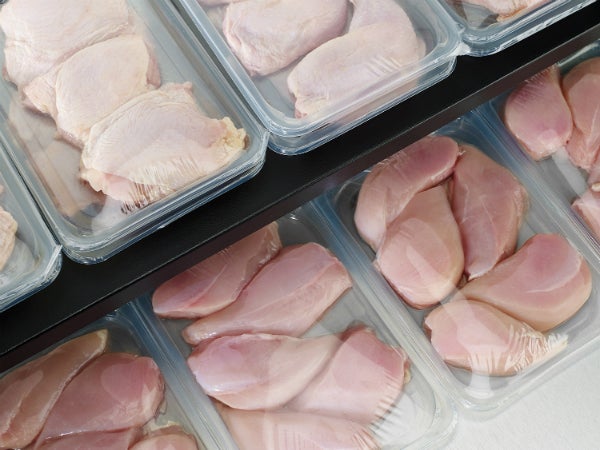
Innovation in poultry packaging is driving change in the sector as European packers and retailers look for more sustainable and novel solutions to maximise sales, according to Alan Davey, innovation director, at fresh food packaging manufacturer, LINPAC.
Traditionally, polypropylene (PP) has been the material of choice for poultry packaging in several parts of Europe, but limitations in terms of its environmental credentials, barrier performance and shelf appeal have resulted in increased demand for Rfresh PET packaging.
Mr Davey at LINPAC said: "Changing consumer lifestyles and heightened awareness of environmental issues, such as food and packaging waste, are behind this shift from PP to Rfresh PET packaging.
"PET has been a popular choice for poultry packaging for some time but the full range of benefits that the material has over PP are only just beginning to be recognised by packers and retailers. Beyond the aesthetic benefits given by PET’s clarity and sparkle, lie environmental credentials and much better gas barrier performance. But PET also introduces greater production efficiencies to packing lines."
Trays manufactured using rPET laminated to PE can be sealed at reduced temperatures in comparison to PP trays and as a result use less energy. For example, to seal 70 million PP trays at 200°C requires 196,000kWh of energy compared to 131,000kWh to seal the same number of rPET/PE trays at 150°C.
Environmentally, rPET fulfils the criteria for creating a circular economy by conserving resources and reducing waste. At LINPAC, a wide range of PET/PE and rPET/PE poultry trays are manufactured that are fully compatible with existing packing and sealing lines and available with complementary lidding films, offering customers a high performing complete pack solution.
Mr Davey continued: "Our rPET trays are manufactured using in excess of 95% post consumer recyclate, which has been supercleaned in-house at LINPAC to ensure all food safety regulations are being exceeded.
"At the end of their service life, the trays can also be recycled back into the food packaging chain. This is not the case with PP trays though as PP is commonly used for a number of non-food packaging applications, for example chemical garden products, that end up back in the same recycling chain, contaminating the flake and making it unsuitable for further food packaging use.
"Furthermore, the carbon footprint of our rPET trays is typically 10%-15% less than competitive PP trays thanks to the use of recyclate allied to the latest tray designs produced by the LINPAC Lightweighting For Excellence (LIFE) programme that’s been running at the company for the past four years."
But there’s even better news! The Rfresh® Elite solution from LINPAC is the ultimate sustainable solution for poultry packaging. The novel design uses a patented sealant on the tray flange to create a secure seal with the lidding film, removing the industry standard laminated PE base film and creating an rPET tray which is recyclable at the end of its service life just like a PET bottle.
The unique sealing system offers the strongest seal strength in its class delivering excellent pack robustness to enhance shelf life and reduce food waste. The excellent seal quality results in less packs failing during packing, transit, and in store, minimising mark-downs and food waste in the store and at home.
PET is also more suited to the demands of a global supply chain, offering a significantly improved gas barrier compared to PP, enhancing the shelf life of poultry contained within and helping to minimise food waste both in-store and at the consumer level.
"Barrier performance is increased by up to 50 times when using PET packaging," said Mr. Davey. "Whilst consumers may be shopping more frequently, the supply chain is becoming more complex so it is imperative that packaging helps to retain product freshness so that poultry looks appealing once it reaches the supermarket shelf."
Research has shown that consumers spend three times longer choosing their meat and poultry in store, in order to assess its freshness, compared to other food items. PET aides purchasing decisions by offering crystal clear tray presentation compared to the cloudy appearance of PP. However, this clarity can also present a challenge for retailers as poultry isn’t always attractive in its raw state.
Mr Davey added: "As a result, innovation in poultry packaging is currently very much focused on improving on-shelf appearance through the use of high quality graphics, novel shapes and sizes, as well as encouraging purchasing by promoting convenience and ease of use. Generally, consumers dislike handling raw meat, particularly poultry, so any type of packaging which promotes a ‘happy chicken story’ and minimises handling in the kitchen is liked by shoppers, particularly in view of the latest campylobacter scares."
New technologies and innovations for the poultry market include ‘straight-to-oven’ bags, flexible flow packs, vacuum skin packaging (VSP), packs complete with complementary sauces, laminated back boards or trays which offer traditional designs helping to present poultry as farm fresh or organic and boxed packs with windows.
For example, the LINPAC range of Rfresh rPET ‘split packs’ help to reduce food waste and tap into the consumer need for convenience. The packs allow contents to be divided into separate portion-size compartments so that consumers can store food in the fridge for longer without compromising food safety.
Mr. Davey said: "Well-designed packaging can help consumers buy the right amount of food and then keep it in the best condition for longer. Our split packs are designed to meet the ‘eat me, keep me’ trend. For example, consumers can buy four chicken fillets, open one side of the pack and use two, then put the remaining two in the fridge in a pack which is still completely sealed, with all the properties of an unopened pack.
"The drive towards sustainable packaging is already changing the poultry packaging sector, the move from PP to PET is evidence of that, but as retailers look beyond environmental credentials to boost sales of poultry products it appears that innovative pack design, on-pack graphics and added value packaging that offers increased convenience will be critical factors for packaging manufacturers to take notice of."

